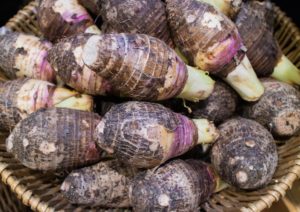
Taro root is high in fiber along with other nutrients, making it a great health food to add to your diet. Here are five benefits of taro root and why you should eat more of it.
5 Benefits of Taro Root
High in fiber and nutrients:
Fiber is essential not only for regularity of the bowels, but it is also key in managing cholesterol levels too. One cup of cooked taro root has 187 calories, less than one gram of protein and fat, 6.7 grams of fiber, 30 percent of your daily intake of manganese, vitamin B6, E, potassium, copper, vitamin C, phosphorus, and magnesium.
May aid in blood sugar control:
Although a starch vegetable, taro root has fiber and resistant starch, which prevents spikes in blood sugar levels.
May reduce the risk of heart disease:
Fiber and resistant starch are also beneficial in reducing the risk of heart disease. Studies have shown that persons who consume high amounts of starch have lower rates of heart disease. Resistant starch has also been linked to lower cholesterol levels, which is important to protecting the heart.
Aid in weight loss:
Studies have shown that people who consume high amounts of fiber tend to weigh less than those who don’t consume as much. These persons also tend to have lower body fat. Consuming resistant starch has also been linked to consuming fewer calories throughout the day.
Good for gut health:
Because fiber and resistant starch aren’t absorbed, it stays in the intestines, where they become food for gut microbiomes. This helps promote the growth of healthy gut bacteria.
How to Incorporate Taro Root into Your Diet
If you want to start benefitting from all taro root has to offer, here is how you can incorporate it into your diet.
- Make taro chips by slicing the taro and baking it
- Steam and mash the taro like you would mash potatoes
- Blend taro or use a taro powder to steep it as tea
- You can bake taro in dough
- Mix taro with seasonings and fry it as a cake
- Cut chunks of it to add to stews and soups
Taro much be consumed cooked, because when raw, it contains protease, which can sting or burn the mouth. This deactivates when cooked.
Also Read: